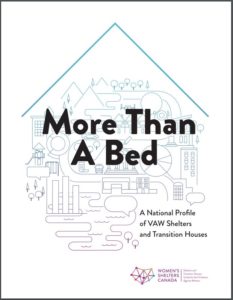Since their inception in the early 1970s, the extent of the work carried out by VAW shelters has substantively increased to respond to the needs of women and children fleeing violence. Every year, violence against women results in thousands of women and children living in fear, with many fleeing for their lives. In addition to providing safety, VAW and second stage shelters help women rebuild their lives, heal from abuse, develop resiliency, and move towards living violence-free lives.
Shelters, feminist scholars, and policymakers have long recognized the need to better understand the scope of services and supports provided to women and children fleeing violence at the national level. Together with shelters, WSC developed a survey with the objective of building a comprehensive national profile of both VAW and second stage shelters. The survey examined the services shelters offer, human resources, prevention work, funding, accessibility, and the challenges faced in all these areas.
Overall, 401 shelters and transition houses participated in the survey, including responses from each province and territory as well as from rural, remote, and Northern shelters and Indigenous shelters.
From the survey data, WSC produced two comprehensive reports: one on short-term, emergency VAW shelters/THs and one on longer-term, second stage shelters. Click on the reports below to find out more.


